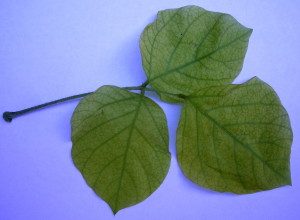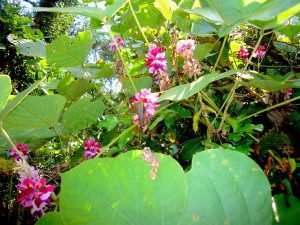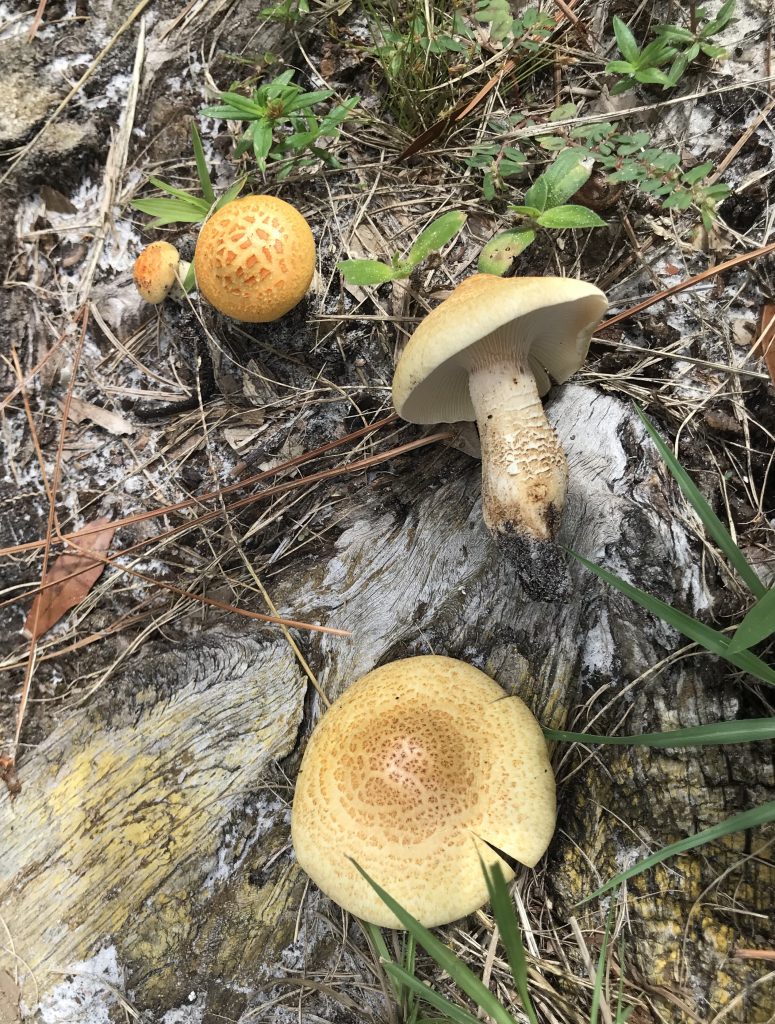
Our local shiitake relative, the Train wrecker. Photo by Green Deane
Are there any Shiitake mushrooms locally? The answer is yes and no. There are some relatives of the famous species both edible and too tough to eat. An easy one to identify that we saw Sunday is Neolentinus lepideus, sometimes called the Train Wrecker. The scientific name means new resembling pliable nice. The name is not too helpful. The Lentinus genus is one with a lot of flexible but very tough mushrooms usually because of the polysaccharide chitin. The “neo” comes from DNA testing that shows they are different than the European versions which were named first. So they get to keep the genus name Lentinus whereas the North American ones were renamed Neolentius. At least two mushrooms locally are called “Train Wrecker” because they grow on railroad ties (and on other treated wood such as fence posts.) During our foraging class at Mead Garden last Sunday we saw several edible puffballs and some Neolentinus lepideus. They are an occasional find rather than a seasonal flush.
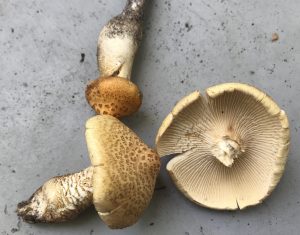
Saw-toothed gills and scales on the stem aid identification. Photo by Green Deane
This “train wrecker” (aka Scaly Sawgill) is fairly easy to identify. First, it grows on pines, dead pines, or pine stumps. There are reports that it is occasionally found on oak. It’s a good sized mushroom with an extremely tough stem. (It’s difficult to pull off the wood.) That stem has tufts pointing up. The gills are kind of saw-toothed, the caps have scales. Spore print is white. The edible mushroom comes with a lot of warnings because it can grow on treated wood. There are fears it can absorb chemicals from the treated wood it is digesting. I only eat the ones I find on pines or pine stumps. I routinely see this species on treated fences at George LeStrange Preserve in Ft. Pierce which by their color suggest the posts are preserved wtih Chromated Copper Arsenate. I leave those where I find them. The cooked mushroom reduces a lot but has a nice flavor and texture. They are more a snack or an addition because one rarely finds more than one or two growing at a time.
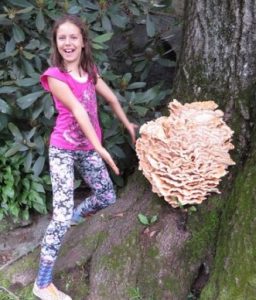
Violet Brill and Chicken of the Woods. Photo by Steve Brill.
Our first discovery of the weekend in Gainesville was a classic: Chicken of the Woods. That was a bit surprising because they tend to like cooler weather. This one had six shelves so everyone went home with some who wanted it. Among the half a dozen or so easy-to-identify mushroom their edibility is not in doubt but what they taste like is subjective (and they must be thoroughly cooked or an upset tummy can follow consumption.) Some think they have the texture and taste of chicken, hence the name. If they were chopped and cooked in chicken soup I might agree. They remind me of resistant dense bread and take on the flavor of surrounding ingredients. They’re good sliced, browned in olive oil and flavored with salt or teriyaki sauce. That suggests they might also make a good jerky. Our Saturday class also got to pick chanterelles and a few Milk Caps.

Classes are held rain or shine or cold. (Hurricanes are an exception.) Photo by Kelly Fagan.
Foraging classes: Other than dodging hurricanes it’s a nice time of year for foraging. I’m going to visit both coasts this weekend, Sarasota and Melbourne.
Saturday September 4th, Red Bug Slough Preserve, 5200 Beneva Road, Sarasota, FL, 34233. 9 a.m. to noon. Meet by the parking lot.
Sunday September 5th, Wickham Park: 2500 Parkway Drive, Melbourne, FL 32935-2335. 9 a.m. to noon. Meet at the dog Park.
Saturday September 11th, Dreher Park, 1200 Southern Blvd., West Palm Beach, 33405. 9 a.m. to noon, meet just north of the science center.
Sunday September 12th, Colby-Alderman Park: 1099 Massachusetts Street, Cassadaga. Fla. 32706. 9 a.m. to noon, meet near the bathrooms.
Saturday September 18th, Bayshore Live Oak Park, Bayshore Drive. Port Charlotte. 9 a.m. to noon, meet at the parking lot at Bayshore and Ganyard Street.
October 9th and 10th, Honea Path, South Carolina, classes at 9 a.m. and 1 p.m. each day. 1624 Taylor Road Honea Path, SC 29654.
For more information, to pre-pay or sign go here.
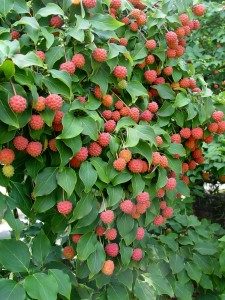
Kusa Dogwood Fruit. Photo by Green Deane
In the backwoods of Maine where I grew up Dogwoods were small. Perhaps the weather and the species conspired to make them inconspicuous. They did not prepare me for more flamboyant Dogwoods including Kousa. A popular ornamental and escapee, Kousa Dogwood does have edible fruit. Whether you will like it or not is a different debate. When I was in North Carolina studying mushrooms at an agricultural center I noticed the landscaping around the main center was quite coiffured. But next to a lower parking lot where the forest met the pavement was a Kousa Dogwood happily invading the hallow agricultural ground. They were not originally planted for their fruit but rather their attractive blossoms. By the way, one of the ways to identify a Dogwood is to carefully tear a leaf apart across the veins. A latex in them will form threads and hold the two separated parts of the leaf together on white webs. To read more about the Kousa Dogwood go here.
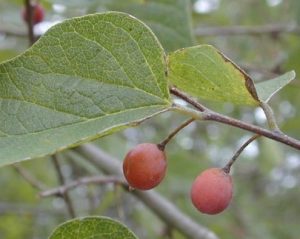
Hackberries, or sugarberries, are usually burnt orange in color.
People launch into arguments over the common names of plants. That should not come as a surprise: Botanists get into arguments over the official names of plants. So is the tree a “Sugarberry” or a “Hackberry?” Some will argue the distinction is geographic, other will assert the names apply to different species. I call it a big tree with little burnt-orange fruit that is edible around now. In real estate it is “location, location, location.” Hackberries-Sugarberries like to be near fresh water such as lakes, ponds, streams or a very reliable irrigation-sprinkler system. They don’t like being waterlogged. But you won’t find them on the top of a dry hill either. Usually you can find them up the bank from water. Older trees usually have warty bark, no thorns. Leaves have uneven shoulders, one down or one up, and on the back side of the leaf notice three prominent veins at the base. Often the leaves have many insect galls and or a black smut on them (the latter does not affect the tree or us. It is also found on useable persimmon leaves.) The pea-sized fruit is burnt to medium orange in color sometimes red depending on the species. The entire fruit is edible though the seed is hard. So you can eat the pulp, and or crunch the seed, or mash entire fruits into cakes. To read more about the Hackberry or Sugarberry go here.
Kudzu is known as the plant that smothered The South. It leaves the impression that if you fell asleep in a lawn chair at noon by supper time you would be covered by Kudzu. Driving or hiking through places like the Carolinas one can see steep hillsides thickly blanked with the large, herbaceous vine. But it is the botanical beast it’s purported to be? We see it in my foraging classes in Cassadaga.
What important to us is that nearly the entire plant is edible: Leaves, growing tips, grape-scented blossoms, young roots and older root starch. Only the seeds are not edible by humans. However the plant does support wild life and domestically goats are particularly fond of it. Turning Kudzu into goat products is profitable, tasty and sustainable. While Kudzu can be a local problem its invasiveness has been exaggerated by regional writers.
Kudzu was first championed during the Dust Bowl Era of the 1930’s because it was the prime plant for fighting erosion. Folks were paid to sow it on their land (no complaining then.) About a million acres were planted in the next 20 years then the program ended. Kudzu meanwhile had worked its way into southern novels and folksy observations. It became a southern cliche. In reality Kudzu occupies about one tenth of one percent of the South’s 200 million acres of forest, or 227,000 acres. Asian Privet, which is rarely commented on by anyone, occupies some 3.2 million acres, 14 times that of Kudzu. The vine is spreading but at a thousandth-something rate of around 2,500 acres a year. And in time it might be significantly reduced: A few years ago a Japanese Kudzu bug was found in a garden in Atlanta (a city which is six times the size of the Kudzu infestation.) The bug was a stowaway on some plane. It is now successfully devouring Kudzu. In one test site it ate a third of the Kudzu in two years. In decades to come Kudzu might be but a bucolic memory, a quaint reference to how it used to be. To read more about Kudzu, go here.

Green Deane videos are now available on a USB.
My nine-DVD set of 135 videos has been phased out and replaced by a 150-video USB. The USB videos are the same videos I have on You Tube. Some people like to have their own copy. The USB videos have to be copied to your computer to play. If you want to order the USB go to the DVD/USB order button on the top right of this page or click here. That will take you to an order form. I’d like to thank all of you who ordered the DVD set over the years which required me to burn over 5,000 DVDs individually.

Green Deane Forum
Want to identify a plant? Perhaps you’re looking for a foraging reference? You might have a UFO, an Unidentified Flowering Object, you want identified. On the Green Deane Forum we — including Green Deane and others from around the world — chat about foraging all year. And it’s not just about warm-weather plants or just North American flora. Many nations share common weeds so there’s a lot to talk. There’s also more than weeds. The reference section has information for foraging around the world. There are also articles on food preservation, and forgotten skills from making bows to fermenting food.
This is weekly newsletter #472. If you want to subscribe to this free newsletter you can find the sign-up form in the menu at the top of the page.
To donate to the Green Deane Newsletter click here.

